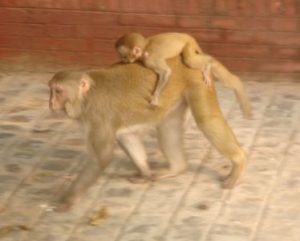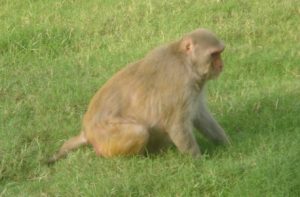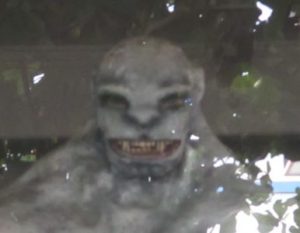
© Sirens Call Publications
My short story The Watchers in the Forest, which is attributed to the pseudonym Jim Mountfield, can now be read in issue 62 – the summer 2023 edition – of the fiction and poetry magazine The Sirens Call.
Much of the writing in this issue is on the theme of cryptids – a ‘cryptid’ being defined by the Merriam-Webster dictionary as “an animal (such as Sasquatch or the Loch Ness Monster) that has been claimed to exist but never proven to exist.” Accordingly, the young hero of The Watchers in the Forest one day notices something strange in the woodland that rises at the end of his grandparents’ garden, woodland in which there have been reports of mysterious ape-like creatures, and unwisely goes to investigate…
As usual with The Sirens Call, issue 62 is the sort of bargain that’s rare nowadays. It contains 274 pages and features 169 stories and poems, yet is available free of charge. It can be downloaded here.
Incidentally, while we’re on the subject of ape-like cryptids, here are my five favourite examples of them from the real world. Well, I don’t think any of them are real, but there have certainly been real reports about them.
The Big Grey Man of Ben Macdui
This is Scotland’s number-one simian-cryptid. The Big Grey Man of Ben Macdui (Am Fear Liath Mòr in Gaelic) is a huge, hairy creature that’s supposed to follow and loom up terrifyingly behind lone hikers and climbers on the country’s second-highest peak, the often-misty Ben Macdui in the Cairngorm Mountains. Alas, nice though the idea of ape creatures lurking in Cairngorms is, I’m inclined to attribute the sightings of the Big Grey Man to the creepy optical effect known as the Brocken Spectre. This involves the sun casting your shadow from a high position onto mist, fog or cloud and making it look monstrous.
The Bukit Timah Monkey Man
Fabulously, an ape-like cryptid is rumoured to stalk my current abode, Singapore, the island city-state that has an area of just over 700 square kilometres and is the third most densely populated nation in the world. If cryptids can escape detection here, they can do it anywhere. It’s said the Bukit Timah Monkey Man was originally sighted in 1805 and most recently in 2020. In the intervening two centuries, those who claim to have seen the beast include Japanese soldiers during their country’s occupation of Singapore in World War II.
The Monkey Man’s sightings have centred around the Singaporean district of Bukit Timah where, on the slopes of Bukit Timah Hill (Singapore’s highest peak at 164 metres) there’s a nature reserve with a population of crab-eating macaque monkeys. It’s assumed that people have seen the real monkeys in poor visibility and distorting light conditions and mistaken them for the cryptid. Though as the crab-eating macaques are at most a half-metre long, and the Monkey Man is supposed to walk upright at a height of 1.75 metres, it seems an odd mistake to make.
A fixture in Singaporean popular culture, the Bukit Timah Monkey Man is sometimes known by the abbreviation BTM, which makes him sound like a Korean-Pop boy-band.
The Monkey Man of Delhi
Delhi is no stranger to monkeys. The last time I was in the city, in 2014, I couldn’t believe the size of the monkey-gangs that were roaming the streets in the neighbourhood of the Indian parliament. They swaggered about as if they owned the place. Predictably, I heard jokes from local people about the parliament being full of monkeys in more way than one.


However, in 2001, the city’s monkey phenomenon took a sinister turn with reports about the Monkey Man of Delhi. According to eyewitnesses, this apparition was a simian-type creature that ranged from four feet to eight feet in height. It was seen about 350 times and supposedly attacked and injured some 60 people, even causing a couple of deaths. The Monkey Man of Delhi’s reign of terror has been attributed to mass hysteria, not unlike the Spring-Heeled Jack panic that gripped Britain nearly two centuries earlier. Thus, the creature is probably more of an urban myth than a ‘real’ cryptid.
The Monkey Man of Delhi had some surprisingly human tastes in accessories. His Wikipedia entry mentions how eyewitness accounts had him not only “covered in thick black hair” but also endowed with “a metal helmet, metal claws, glowing red eyes and three buttons” on his chest. “Some reports also claim that the Monkey Man wore roller-skates.”
The Nittaewo
Sri Lanka, the country where I lived from 2014 to 2022, is also home to tales of anthropoid cryptids. The Nittaewo were said to be a species of bipedal, tailless primates dwelling in the nation’s forests, with talon-like fingers and a strange language that resembled the twittering of birds. According to the traditions of the Vedda people – who are believed to be Sri Lanka’s oldest human inhabitants – the Vedda fought against and finally destroyed the Nittaewo in the 18th century. All the same, there have been alleged sightings of the Nittaewo since then, indeed, as late as 1984.
But if you go down to the Sri Lankan woods today and hear strange rustlings and twittering sounds coming from the undergrowth, you needn’t be too alarmed. The Nittaewo were said to be three feet tall at most. So if they did exist, they shouldn’t have looked any more threatening than a Hobbit.
The Yeti
Obviously, the Yeti, the Abominable Snowmen of the Himalayas, vie with Bigfoot as being the world’s most famous ape-like cryptids. I like them for two reasons. Firstly, they inspired the haunting, wistful song Wild Man by Kate Bush, released in 2011. (“Lying in my tent, I can hear your cry echoing round the mountainside / You sound lonely…”)
Secondly, I used to see a yeti regularly in Colombo, the Sri Lankan capital. The venerable street-side walkway on York Street in the city’s downtown area had a huge fibreglass yeti hulking behind, and glowering out through, one of its shop windows. The thing had been created as an eye-catching advertising gimmick for a product called Yeti Isotonic Energy. This was a rehydrating sports drink “developed in collaboration by Austrian and Sri Lankan scientists”, and bottles of it were on display in the same window.
I wonder if he’s still there today?


